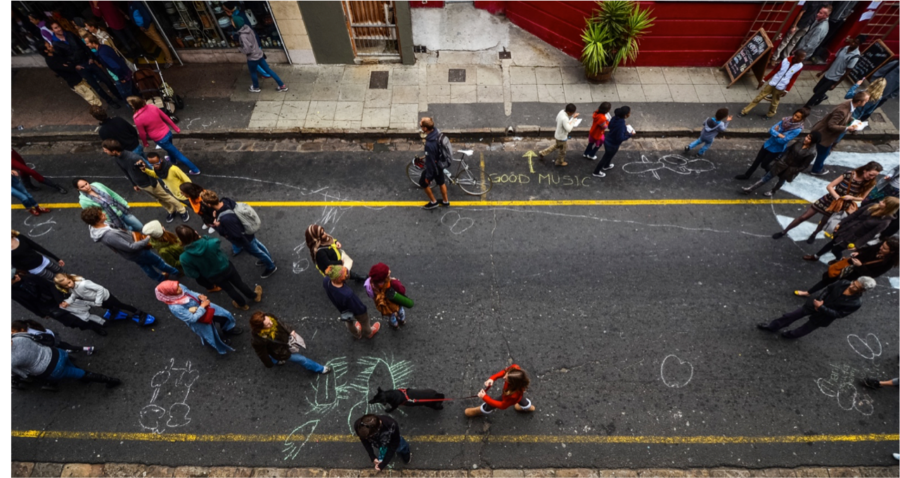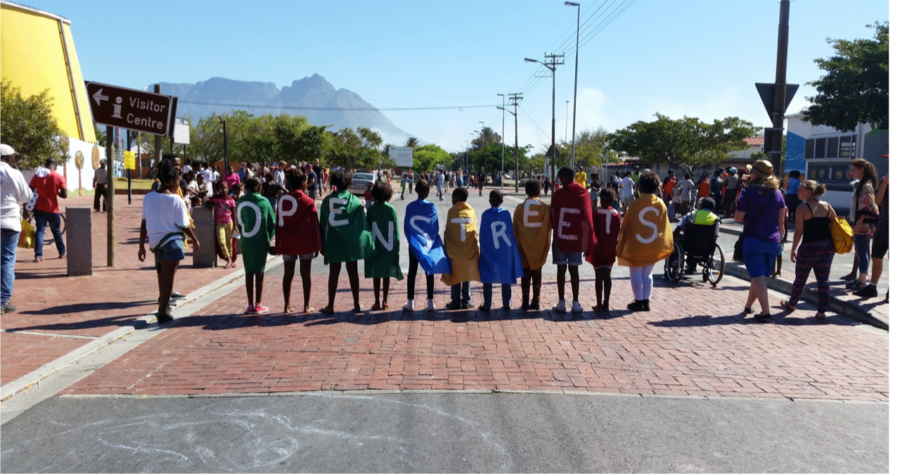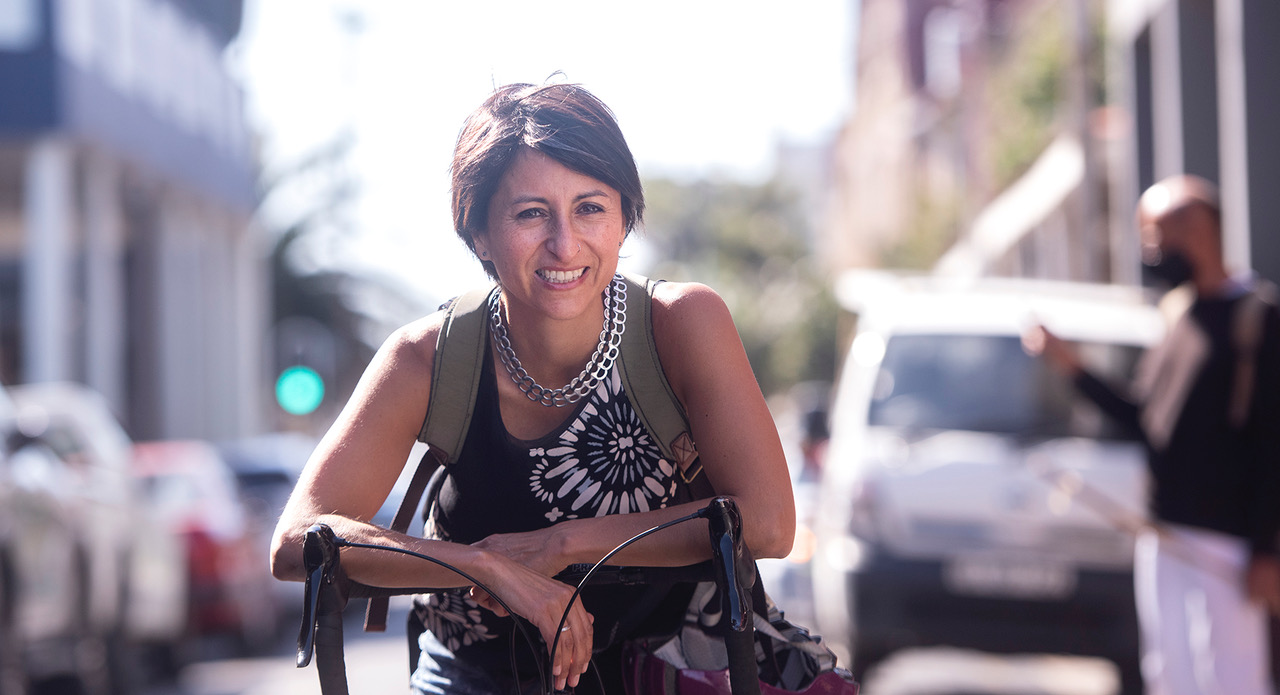10 min read.
Marcela Guerrero Casas is the Co-Founder & former Managing Director of Open Streets Cape Town. She has worked in policy and advocacy for almost ten years in organisations including The Carter Center, CIVICUS: World Alliance for Citizen Participation and Fairtrade Africa. Marcela is also a cofounder of SUR Collective, a platform for cultural exchange between Latin American and Sub-Saharan African countries.
How did you become involved in active mobility and public space advocacy, and how did the Open Streets Cape Town project come to be ?
I moved to South Africa in 2006. I was born and raised in Colombia, and I had lived in the US for a while before. I had worked in various fields of advocacy and in 2012, when this whole Open Streets story began, my job was with Fair Trade. I was working for a regional network, and it sometimes felt difficult to connect to the work that was happening all over the African continent. Initially, it was very much a personal interest in creating something that had a local impact. I’m not a transport specialist or an urban planner by training, but I would call myself a very active resident. In every place I’ve lived I’ve tried to connect with the people around me and I happened to meet people who shared that vision and who were interested in doing something for Cape Town.
One day, I was reflecting with a Colombian friend who also lived in Cape Town about how cool it would be to have a Ciclovía in Cape Town, being familiar with the concept from Bogota. This conversation that we had by the sea one afternoon became something that I started pursuing very strongly. I spoke to city government and to other people who would eventually co-found the organisation Open Streets.
It happened almost accidentally, because we never set out to establish an organisation. The Bus Rapid Transit System (BRT) was already something that the South African government was interested in. Several delegations have been to Bogota, and one delegate had liked Ciclovía so much that she spearheaded that idea back in 2003. It’s important to recognise that the idea didn’t come out of nowhere. Open streets had already been tested in 2003-2004 in Cape Town but it didn’t stick and we wanted to give it another try.
When we began however it felt like we were starting from scratch. People initially didn’t really understand why we would want to shut down the streets. This time though, it really gained a lot of interest and momentum within the first year and then one thing led to the other, and we established an organisation. Reflecting on its beginnings, it was very much about people who wanted to do something in Cape Town, and the street just became the conduit, both in a symbolic way but also in a very literal sense. I left the organisation in January 2019 so I’m no longer directly involved, but I of course stay in touch.

A key element of these activations is that they temporarily change how we use and think of a space, the street, without altering its physical form. How do you think this helps urban dwellers develop a new, more sustainable mindset around active mobility, and of the role of streets in urban life?
In Cape Town, and most South African cities, people are already walking and cycling. It’s not like they need to be further prompted, which is probably the case in North America, where people are so car reliant. The dynamic is very different here. The dilemma is to provide the kind of infrastructure that makes what people are already doing safer. Maybe cycling isn’t common or widespread as it is in many Latin American countries, but walking certainly is. It’s however not safe from an infrastructure perspective but also from a crime perspective. The Open Streets that we held provided an opportunity, a window into the experience of joy in our streets. I know that that’s very intangible, but there’s something within this joy that is the first step in creating those important shifts that we’re looking for. In the long term, it really does come down to tackling those bigger issues. And here, I would dare say that safety is, if not the biggest, one of the most crucial challenges that our city faces.
Cape Town remains segregated along racial and economic lines. The vision of Open Streets is that they should provide platforms for creative expression of local cultures & values. Can you speak to how Open Streets Cape Town enabled the strengthening of the city’s social fabric by connecting people and bridging social divides?
There’s an anecdote from the early days that I think responds well to your question. We were initially asked to pigeonhole the programme either in the Transport Department or the Social Development Department. After some thinking we realised there was no decision to be made to be made however. There was never an either or, it was always about both, because in a city that is as segregated as Cape Town, you can’t have functional transport systems if the city is fractured by big highways, and also by cultural and social divisions. Obviously, mending this takes generations, it’s not like with an Open Streets programme, even if it was happening every Sunday, that it was going to happen overnight. There are issues around affordable housing, when and where people have to travel, it’s a very complex situation.
We quickly realised however that Open Streets was very much about yes, encouraging people to cycle and to walk because it was a safer environment, but also definitely to create a space for people to experience the city differently. It also provided a reason to go to a different kind of Cape Town, because very often people here don’t easily move out of their bubbles, partly due to the geographic layout of the city and its design, but also because there are barriers in terms of language, culture, and lots of different things. Creating this space for people to visit each other was a really powerful tool. And it worked.
A series of low-carbon related transport campaigns and creative stakeholder engagement have been developed as part of the Open Streets days. How do these initiatives fit within the vision of Open Streets Cape Town?
There was a very intentional approach to using the street as a platform for engagement, for showcasing and for sharing. We attracted around 10-20,000 people at most during our events, so it wasn’t like in Bogota where millions of people come out to the Ciclovía however still enough to really reach an audience. That meant we didn’t just make it about Open Street days. We ran an initiative called travel diaries for example, that was part of a programme that was sponsored by a local fund called the Green Trust. They wanted to see how open streets could help, motivate, the adoption of more sustainable transport. We were essentially leveraging the Open Streets days as moments to highlight and reflect upon the other work that we were doing during the rest of the year.
How do you think such ephemeral interventions can help create a culture of active transportation ?
It’s difficult to quantify how those kinds of initiatives contribute to the long term development of sustainable transport. It’s quite widely recognised in academia that Open Streets are really useful as a way of getting civil society involved in urban processes. I definitely agree with that but there also needs to be support from policymakers. Without it, things don’t go very far. The aim was always to get Open Streets to be a government programme so that it would happen regularly, a budget would be allocated, but that hasn’t happened yet. It continues to be an uphill battle in our city unfortunately. There’s a lot of power and there’s a lot of potential, but by itself is not gonna do the trick.
Having said that, I went back to Colombia last year and when I came back, lots of former colleagues, or volunteers that were a part of Open Streets had started their own initiatives in their areas. There are two townships outside of Cape Town, Langa and Khayelitsha, that now have community bicycle shops, are organising bicycle buses and other coordinated groups rides. In a way, the philosophy of Open Streets has stayed on and is popping up in other areas. Of course, it’s difficult to quantify or to take credit for these changes because there’s obviously a combination of factors. People seem to be open to cycling at the moment, not unlike other parts of the world, so there are many conditions that are making this possible. I do think however that Open Streets as an organisation, as a movement, and as a group of people had something to contribute to what we’re seeing now.

You mentioned the need for government support. What were some main challenges that you faced over the years that you had to overcome?
So let me start with the positive. We developed really good relationships with some government officials. In the early days I remember the head of transport thought we were bugging him and eventually told us he was so glad we insisted because he thought it was a great programme.
The less positive side is that the city has lots of regulation. A lot of stakeholders are reluctant to try something new and everything requires a permit. People still say that closing one street will bring the city to a standstill, even though it’s been proven time and time again that it doesn’t. There’s that sort of dissonance where you know you’re doing something positive but city officials are still very afraid to give it a go and support it, to create an enabling environment. That hasn’t changed much unfortunately. Even during COVID, it’s said that city officials are more open to thinking about public space differently but when it comes to it, you are read from the book again: “have you read this study, have you gotten this permit, and what about this bylaw”. In the early days myself and my co-founders were quite naive and just pushing the boundaries, but overtime I’ve become more cynical. It’s a really difficult challenge to overcome.
You developed an “open streets toolkit” to guide other cities that want to embrace open streets – what do you think are some key strategies to make these a success?
This might seem contradictory to my previous answer, but it’s so important in a way to be naive, to be ambitious, to be romantic, and to not don’t be afraid to dream big. When we had that first Open Streets day, it was so much work but then on the day we had that sense that we had done something really amazing, that we had done together. Looking around, everyone was smiling and no toolkit can describe that feeling.
The toolkit does highlight a set of principles and reminders. The Raahgiri Foundation in India and 880 Cities in Canada also put together similar resources and that contributes to the body of knowledge. In many ways though, it is about just connecting with people putting the right energy into it. The other thing I would emphasise is really to make friends in city government. I feel like we could have done better in seeing city officials also as just people, residents in the streets and in the neighbourhoods we share. One can sometimes tend to be very critical and forget to connect at the human level and try to build those bridges. Those relationships are so key, whether they are your neighbours, your colleagues, or the city official that’s going to help you get the permit, or the funder.
The question of funding is also so important. We were quite precious, in the early days about being non commercial, not having any brands involved. I think that was a mistake, to be honest. So even though I still believe that it should be a non-commercial endeavour, and have strong principles, the private sector plays a role in every aspect of life in the city. So it’s important to set boundaries, but be open hearted, open minded. If people want to help, you will need all the help you can get.
Any last comments?
The biggest lesson I have been able to formulate so far is that Open Streets must remain a tool. It can’t be about just having Open Streets for the sake of having open streets. In the early days, for me personally, I saw it as a need to shut down as many kilometres over and over again. The important conversation though is about why we want to do open streets, and what we want to achieve. In the future maybe will make more sense to develop new cultural programs, campaigns, and different types of interventions that can help us reach our ambitions for the city. We always should remember that this is a tool, a vehicle for change, towards something bigger.
header Photo by Brenton Geach/Maverick Citizen.

